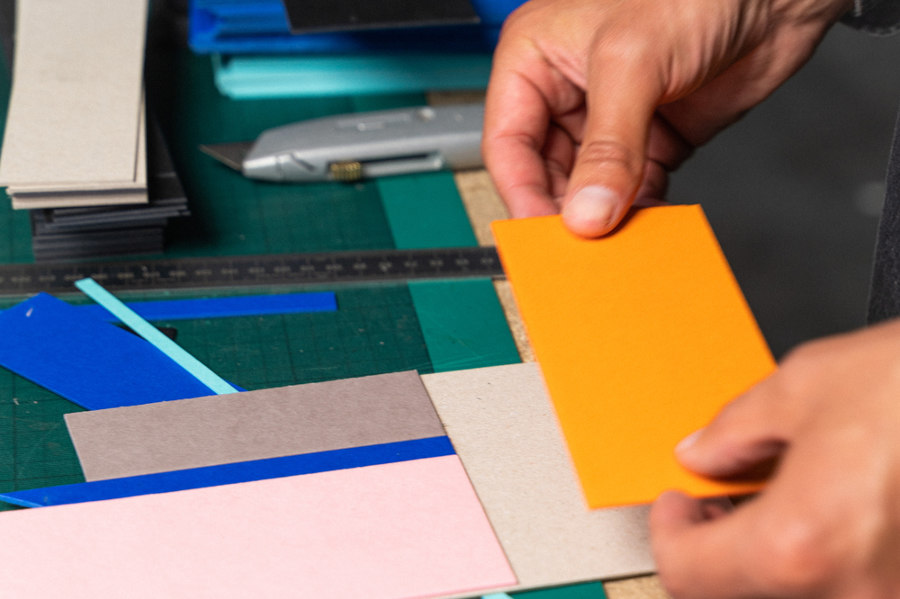London Design Festival: on the Design Trail
Texto por James Wormald
03.10.22
Divided into 12 separate design districts, London Design Festival’s key theme of identity was explored in these installations, exhibitions and workshops from the trail.
One of the most popular workshops at London Design Festival 2022 was Pith’s Creativity with Waste Material, giving visitors free rein with the craft knife and glue. Photo: Pith

One of the most popular workshops at London Design Festival 2022 was Pith’s Creativity with Waste Material, giving visitors free rein with the craft knife and glue. Photo: Pith
×The design industries have gone through immense change over the past 20 years, since the London Design Festival first opened its city’s creative streets, with festivals and fairs like this one consistently educating us on new ideas, materials and methodologies. On the crest of the zeitgeist once again, LDF 22 put its focus on the event’s 20-year history, but also on the future, with inclusivity, identity and sustainability – both of natural resources and the sustainability of communities – key themes.
For far longer than 20 years, London has been a destination where innovative materials, skills and people themselves form a melting pot of culture and community, with each defined area’s past, present and future relationship with design reflecting its own individual character, and the characters of those who call the districts home and work. Each London district has a tale to tell, and those who followed the London Design Festival 2022’s design trail were an audience eager to listen.
Vitra’s showroom at Tramshed (top, middle) retains many original features and surfaces, while Seratech’s carbon-neutral concrete (bottom) creates new ones. Photos: Vitra (top, middle), AKT II (bottom)

Vitra’s showroom at Tramshed (top, middle) retains many original features and surfaces, while Seratech’s carbon-neutral concrete (bottom) creates new ones. Photos: Vitra (top, middle), AKT II (bottom)
×Shoreditch Design Triangle
When long-neglected Shoreditch became home for various tech startups 20 years ago, earning itself the moniker, Silicon Roundabout, a journey towards a world-leading centre for technology and creativity began. Fashion, furniture and hospitality soon followed, and Vitra’s new showroom at Tramshed exhibits Shoreditch’s ability to transform previously mistreated venues into trendy ones, simply by refusing to remodel.
Stripped back and cleaned, the minimalist renovation of the Grade II-listed Tramshed building saw the majority of its surfaces either kept or returned to as close to their original state as possible. Hidden by Old Street roundabout’s huge rebuild, meanwhile, the Crinkle Crankle Concrete installation saw how Seratech’s innovative carbon-neutral concrete can allow construction to continue in Shoreditch, without harming the environment.
Brigid McLeer’s Collateral (top) was displayed in the Crafts Council Gallery while Pith’s workshop created unique notebook covers (middle, bottom). Photos: Brigid McLeer (top), Pith (middle, bottom)

Brigid McLeer’s Collateral (top) was displayed in the Crafts Council Gallery while Pith’s workshop created unique notebook covers (middle, bottom). Photos: Brigid McLeer (top), Pith (middle, bottom)
×Islington Design District
While both Tramshed and Crinkle Crankle Concrete exemplify environmentally-friendly construction or refurbishment, two locations in nearby Islington educated visitors on the past and future of smaller-scale materials. At the Crafts Council Gallery, the dark history of the cotton trade was explored, with artists’ work representing the politics and effect the cotton industry had, both in South Asia and Britain.
Meanwhile, workshops at the Pith store up the road allowed visitors to design their own notebook covers using the colourful offcuts from Pith’s production process. Sending unused material back to the paperworks requires extra fuel and production waste, so the sustainability-focused stationery brand is looking for tighter circular methods of re-use.
God’s Own Junkyard’s Welcome to Walthamstow sign (top), and the Creative Works co-workspace at Gnome House (middle, bottom). Photos: James Wormald (top, bottom), Creative Works (middle)

God’s Own Junkyard’s Welcome to Walthamstow sign (top), and the Creative Works co-workspace at Gnome House (middle, bottom). Photos: James Wormald (top, bottom), Creative Works (middle)
×William Morris Design Line
‘Welcome to the home of people who make and create’ reads a public artwork welcoming visitors to the Walthamstow area, by the world-renowned studio, God’s Own Junkyard. But the slogan isn’t just a marketing fabrication. As another previously neglected London area, historically home to artists, craftspeople and creatives of all kinds, the village-like district has strengthened its sense of community and identity throughout a period of intense gentrification.
Recently named as a Creative Enterprise Zone (ECZ), the Blackhorse Lane area is home to a wealth of independent workshops, studios and co-workspaces such as Blackhorse Workshop, Switchboard Studios, Yonder and Creative Works, all giving space for local brands, startups and independents to live and work close to home.
Patrick Nash’s light-up artworks (top) and Crafting Plastics! 3D-printed bioplastic stool/table/plinth (middle) and vase (bottom). Photos: LDF (top), Crafting Plastics! (middle, bottom)

Patrick Nash’s light-up artworks (top) and Crafting Plastics! 3D-printed bioplastic stool/table/plinth (middle) and vase (bottom). Photos: LDF (top), Crafting Plastics! (middle, bottom)
×Bankside Design District
Walthamstow’s God’s Own Junkyard might be the UK’s neon light-art poster boy, but the arts-and-entertainment-heavy South Bank is where American artist Patrick Nash chose to position his immersive installation of line-drawn light people. Set underneath Southwark’s atmospheric railway arches, Nash asks visitors to consider the spaces in between them and his anatomic forms, instead of the works themselves.
A gentle stroll down the Bankside path, meanwhile, leads one towards the OXO Tower, where the Material Matters exhibition invited various innovative studios and scientific boffins to showcase their latest circular materials, including grower of 3D-printable bioplastics Crafting Plastics! whose plastic-substitutes are 100% biodegradable in as little as six weeks.
Andipa Gallery’s Britain is Best exhibition (top), the Bibendum sofa in Meet Me in the Metaverse (middle) and its virtual counterpart (bottom). Photos: LDF (top), The Conran Shop (middle, bottom)

Andipa Gallery’s Britain is Best exhibition (top), the Bibendum sofa in Meet Me in the Metaverse (middle) and its virtual counterpart (bottom). Photos: LDF (top), The Conran Shop (middle, bottom)
×Brompton Design District
Britain may be a historic juggernaut of trade and creativity, but one thing we Brits are truly terrible at, is self-promotion – even writing this feels horrifically awkward. So the Britain is Best exhibition at Brompton’s Andipa Gallery was a slightly unnerving celebration of paintings, sculptures, tapestries and other works from British greats such as Banksy, Damien Hirst, David Hockney, Peter Burke and Grayson Perry.
As an internationally-respected British voice on design, meanwhile, The Conran Shop housed Meet Me in the Metaverse, pitching six of the shop’s most iconic products into the virtual realm. The installation invites six digital artists to revisit the pieces, which sat alongside screenings of their digitally animated virtual counterparts.
© Architonic
Head to the Architonic Magazine for more insights on the latest products, trends and practices in architecture and design.

























